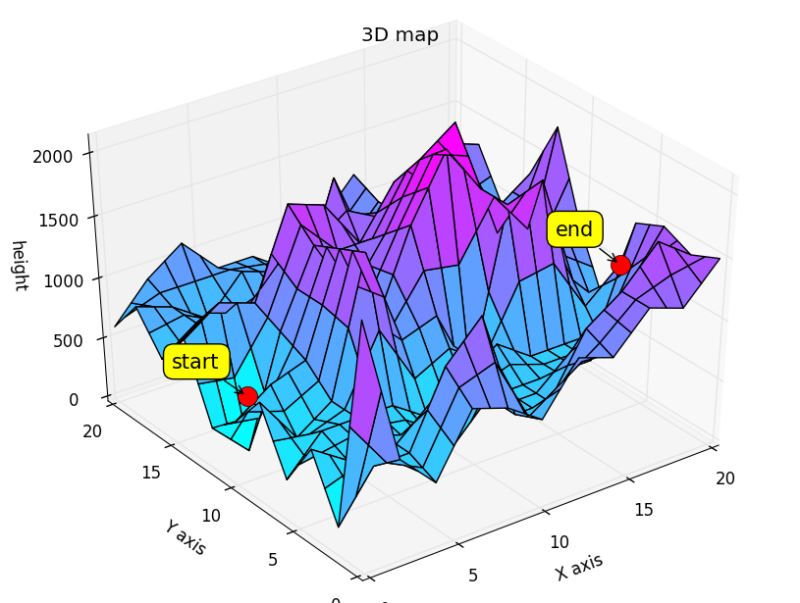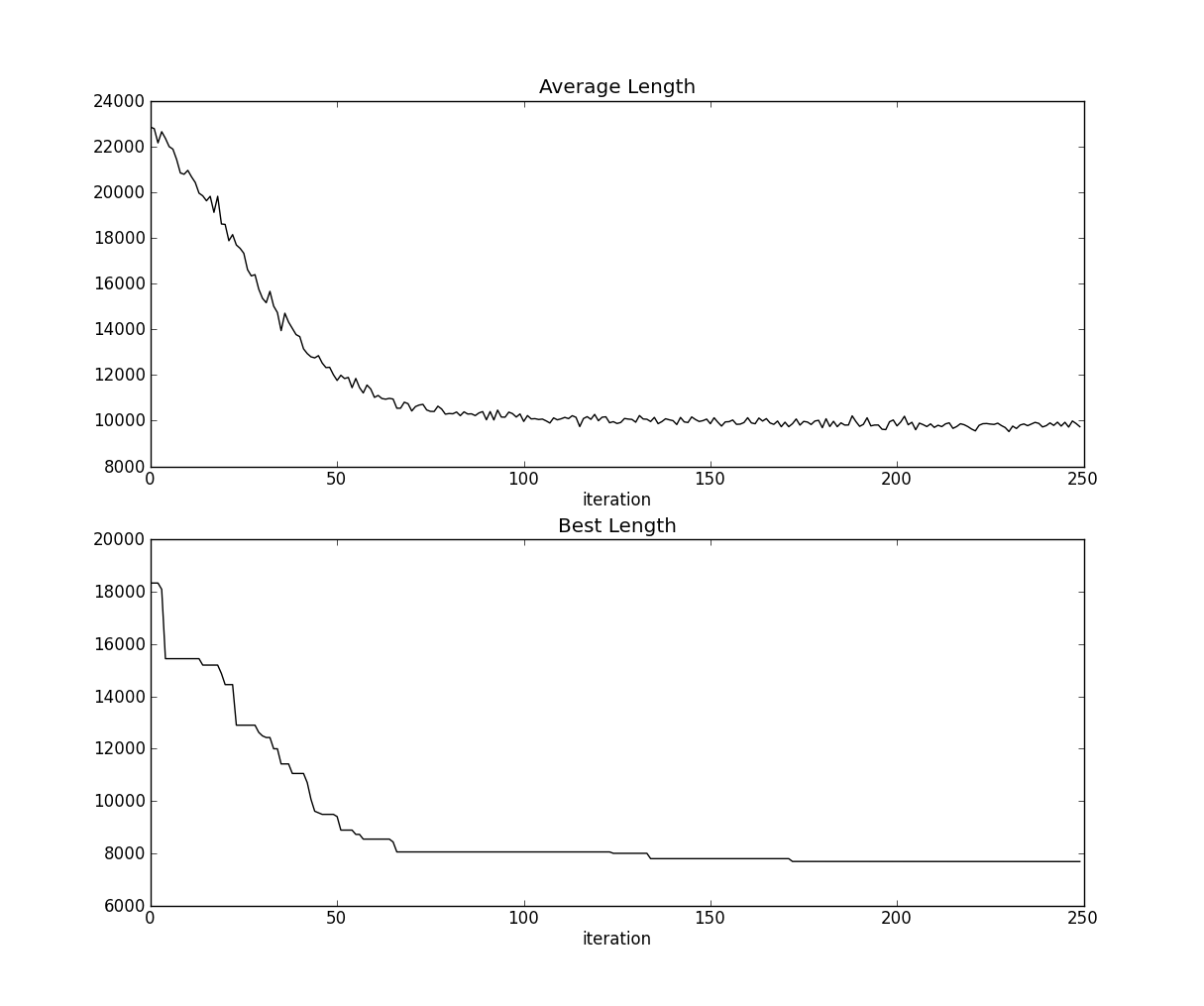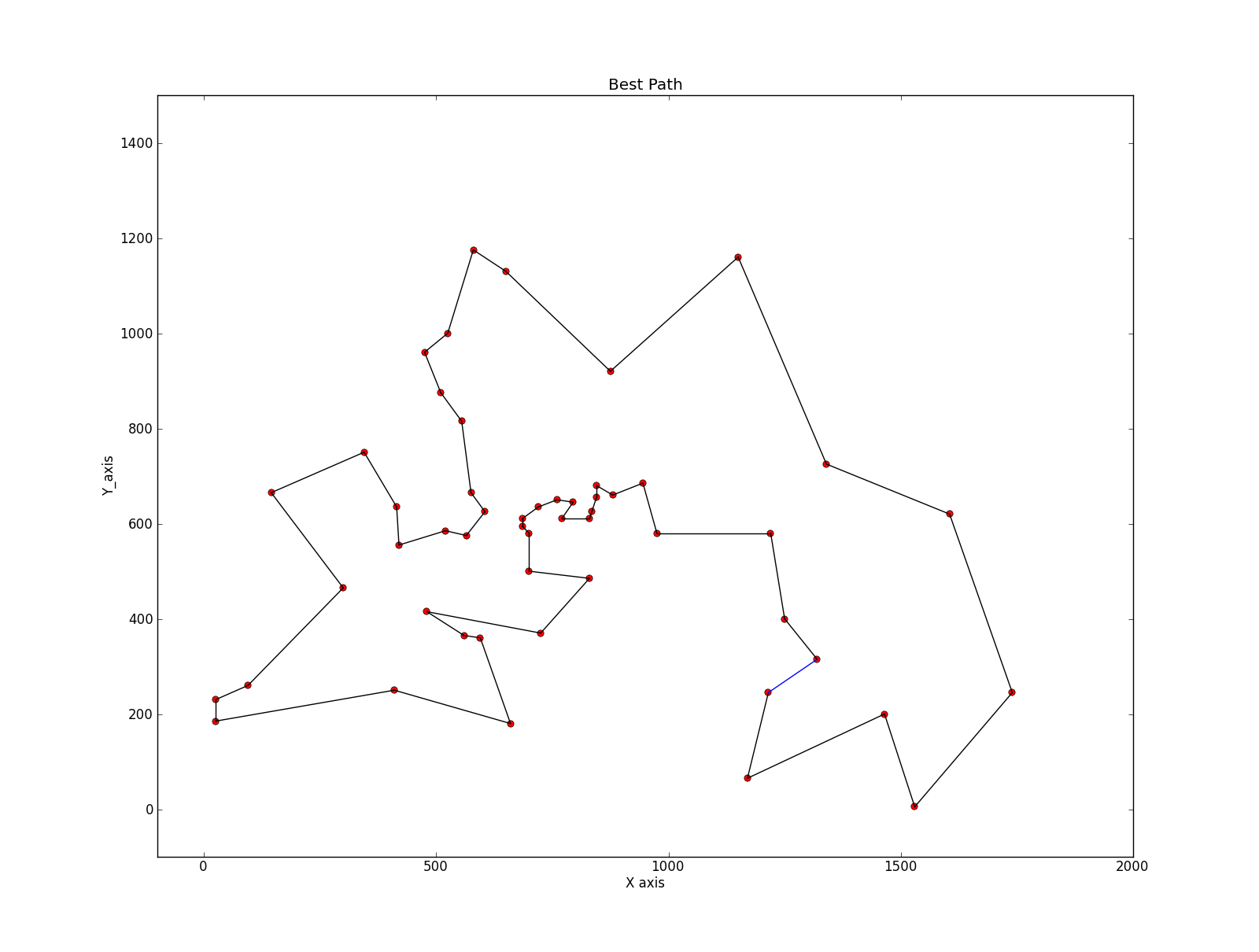- ubuntu12.04环境下使用kvm ioctl接口实现最简单的虚拟机
- Ubuntu 通过无线网络安装Ubuntu Server启动系统后连接无线网络的方法
- 在Ubuntu上搭建网桥的方法
- ubuntu 虚拟机上网方式及相关配置详解
CFSDN坚持开源创造价值,我们致力于搭建一个资源共享平台,让每一个IT人在这里找到属于你的精彩世界.
这篇CFSDN的博客文章Python编程实现蚁群算法详解由作者收集整理,如果你对这篇文章有兴趣,记得点赞哟.
简介 。
蚁群算法(ant colony optimization, ACO),又称蚂蚁算法,是一种用来在图中寻找优化路径的机率型算法。它由Marco Dorigo于1992年在他的博士论文中提出,其灵感来源于蚂蚁在寻找食物过程中发现路径的行为。蚁群算法是一种模拟进化算法,初步的研究表明该算法具有许多优良的性质。针对PID控制器参数优化设计问题,将蚁群算法设计的结果与遗传算法设计的结果进行了比较,数值仿真结果表明,蚁群算法具有一种新的模拟进化优化方法的有效性和应用价值。 定义 。
各个蚂蚁在没有事先告诉他们食物在什么地方的前提下开始寻找食物。当一只找到食物以后,它会向环境释放一种挥发性分泌物pheromone (称为信息素,该物质随着时间的推移会逐渐挥发消失,信息素浓度的大小表征路径的远近)来实现的,吸引其他的蚂蚁过来,这样越来越多的蚂蚁会找到食物。有些蚂蚁并没有像其它蚂蚁一样总重复同样的路,他们会另辟蹊径,如果另开辟的道路比原来的其他道路更短,那么,渐渐地,更多的蚂蚁被吸引到这条较短的路上来。最后,经过一段时间运行,可能会出现一条最短的路径被大多数蚂蚁重复着.
解决的问题 。
三维地形中,给出起点和重点,找到其最优路径.

作图源码:
|
1
2
3
4
5
6
7
8
9
10
11
12
13
14
15
16
17
18
19
20
21
22
23
24
25
26
27
28
29
30
31
32
33
34
35
36
37
38
39
40
41
42
43
44
45
46
47
48
49
50
51
|
from
mpl_toolkits.mplot3d
import
proj3d
from
mpl_toolkits.mplot3d
import
Axes3D
import
numpy as np
height3d
=
np.array([[
2000
,
1400
,
800
,
650
,
500
,
750
,
1000
,
950
,
900
,
800
,
700
,
900
,
1100
,
1050
,
1000
,
1150
,
1300
,
1250
,
1200
,
1350
,
1500
], [
1100
,
900
,
700
,
625
,
550
,
825
,
1100
,
1150
,
1200
,
925
,
650
,
750
,
850
,
950
,
1050
,
1175
,
1300
,
1350
,
1400
,
1425
,
1450
], [
200
,
400
,
600
,
600
,
600
,
900
,
1200
,
1350
,
1500
,
1050
,
600
,
600
,
600
,
850
,
1100
,
1200
,
1300
,
1450
,
1600
,
1500
,
1400
], [
450
,
500
,
550
,
575
,
600
,
725
,
850
,
875
,
900
,
750
,
600
,
600
,
600
,
725
,
850
,
900
,
950
,
1150
,
1350
,
1400
,
1450
], [
700
,
600
,
500
,
550
,
600
,
550
,
500
,
400
,
300
,
450
,
600
,
600
,
600
,
600
,
600
,
600
,
600
,
850
,
1100
,
1300
,
1500
], [
500
,
525
,
550
,
575
,
600
,
575
,
550
,
450
,
350
,
475
,
600
,
650
,
700
,
650
,
600
,
600
,
600
,
725
,
850
,
1150
,
1450
], [
300
,
450
,
600
,
600
,
600
,
600
,
600
,
500
,
400
,
500
,
600
,
700
,
800
,
700
,
600
,
600
,
600
,
600
,
600
,
1000
,
1400
], [
550
,
525
,
500
,
550
,
600
,
875
,
1150
,
900
,
650
,
725
,
800
,
700
,
600
,
875
,
1150
,
1175
,
1200
,
975
,
750
,
875
,
1000
], [
800
,
600
,
400
,
500
,
600
,
1150
,
1700
,
1300
,
900
,
950
,
1000
,
700
,
400
,
1050
,
1700
,
1750
,
1800
,
1350
,
900
,
750
,
600
], [
650
,
600
,
550
,
625
,
700
,
1175
,
1650
,
1275
,
900
,
1100
,
1300
,
1275
,
1250
,
1475
,
1700
,
1525
,
1350
,
1200
,
1050
,
950
,
850
], [
500
,
600
,
700
,
750
,
800
,
1200
,
1600
,
1250
,
900
,
1250
,
1600
,
1850
,
2100
,
1900
,
1700
,
1300
,
900
,
1050
,
1200
,
1150
,
1100
], [
400
,
375
,
350
,
600
,
850
,
1200
,
1550
,
1250
,
950
,
1225
,
1500
,
1750
,
2000
,
1950
,
1900
,
1475
,
1050
,
975
,
900
,
1175
,
1450
], [
300
,
150
,
0
,
450
,
900
,
1200
,
1500
,
1250
,
1000
,
1200
,
1400
,
1650
,
1900
,
2000
,
2100
,
1650
,
1200
,
900
,
600
,
1200
,
1800
], [
600
,
575
,
550
,
750
,
950
,
1275
,
1600
,
1450
,
1300
,
1300
,
1300
,
1525
,
1750
,
1625
,
1500
,
1450
,
1400
,
1125
,
850
,
1200
,
1550
], [
900
,
1000
,
1100
,
1050
,
1000
,
1350
,
1700
,
1650
,
1600
,
1400
,
1200
,
1400
,
1600
,
1250
,
900
,
1250
,
1600
,
1350
,
1100
,
1200
,
1300
], [
750
,
850
,
950
,
900
,
850
,
1000
,
1150
,
1175
,
1200
,
1300
,
1400
,
1325
,
1250
,
1125
,
1000
,
1150
,
1300
,
1075
,
850
,
975
,
1100
], [
600
,
700
,
800
,
750
,
700
,
650
,
600
,
700
,
800
,
1200
,
1600
,
1250
,
900
,
1000
,
1100
,
1050
,
1000
,
800
,
600
,
750
,
900
], [
750
,
775
,
800
,
725
,
650
,
700
,
750
,
775
,
800
,
1000
,
1200
,
1025
,
850
,
975
,
1100
,
950
,
800
,
900
,
1000
,
1050
,
1100
], [
900
,
850
,
800
,
700
,
600
,
750
,
900
,
850
,
800
,
800
,
800
,
800
,
800
,
950
,
1100
,
850
,
600
,
1000
,
1400
,
1350
,
1300
], [
750
,
800
,
850
,
850
,
850
,
850
,
850
,
825
,
800
,
750
,
700
,
775
,
850
,
1000
,
1150
,
875
,
600
,
925
,
1250
,
1100
,
950
], [
600
,
750
,
900
,
1000
,
1100
,
950
,
800
,
800
,
800
,
700
,
600
,
750
,
900
,
1050
,
1200
,
900
,
600
,
850
,
1100
,
850
,
600
]])
fig
=
figure()
ax
=
Axes3D(fig)
X
=
np.arange(
21
)
Y
=
np.arange(
21
)
X, Y
=
np.meshgrid(X, Y)
Z
=
-
20
*
np.exp(
-
0.2
*
np.sqrt(np.sqrt(((X
-
10
)
*
*
2
+
(Y
-
10
)
*
*
2
)
/
2
)))
+
20
+
np.e
-
np.exp((np.cos(
2
*
np.pi
*
X)
+
np.sin(
2
*
np.pi
*
Y))
/
2
)
ax.plot_surface(X, Y, Z, rstride
=
1
, cstride
=
1
, cmap
=
'cool'
)
ax.set_xlabel(
'X axis'
)
ax.set_ylabel(
'Y axis'
)
ax.set_zlabel(
'Z'
)
ax.set_title(
'3D map'
)
point0
=
[
0
,
9
,Z[
0
][
9
]]
point1
=
[
20
,
7
,Z[
20
][
7
]]
ax.plot([point0[
0
]],[point0[
1
]],[point0[
2
]],
'r'
,marker
=
u
'o'
,markersize
=
15
)
ax.plot([point1[
0
]],[point1[
1
]],[point1[
2
]],
'r'
,marker
=
u
'o'
,markersize
=
15
)
x0,y0,_
=
proj3d.proj_transform(point0[
0
],point0[
1
],point0[
2
], ax.get_proj())
x1,y1,_
=
proj3d.proj_transform(point1[
0
],point1[
1
],point1[
2
], ax.get_proj())
label
=
pylab.annotate(
"start"
,
xy
=
(x0, y0), xytext
=
(
-
20
,
20
),
textcoords
=
'offset points'
, ha
=
'right'
, va
=
'bottom'
,
bbox
=
dict
(boxstyle
=
'round,pad=0.5'
, fc
=
'yellow'
, alpha
=
1
),
arrowprops
=
dict
(arrowstyle
=
'->'
, connectionstyle
=
'arc3,rad=0'
),fontsize
=
15
)
label2
=
pylab.annotate(
"end"
,
xy
=
(x1, y1), xytext
=
(
-
20
,
20
),
textcoords
=
'offset points'
, ha
=
'right'
, va
=
'bottom'
,
bbox
=
dict
(boxstyle
=
'round,pad=0.5'
, fc
=
'yellow'
, alpha
=
1
),
arrowprops
=
dict
(arrowstyle
=
'->'
, connectionstyle
=
'arc3,rad=0'
),fontsize
=
15
)
def
update_position(e):
x2, y2, _
=
proj3d.proj_transform(point0[
0
],point0[
1
],point0[
2
],ax.get_proj())
label.xy
=
x2,y2
label.update_positions(fig.canvas.renderer)
x1,y1,_
=
proj3d.proj_transform(point1[
0
],point1[
1
],point1[
2
],ax.get_proj())
label2.xy
=
x1,y1
label2.update_positions(fig.canvas.renderer)
fig.canvas.draw()
fig.canvas.mpl_connect(
'button_release_event'
, update_position)
|
基本原理 。
蚂蚁k根据各个城市间链接路径上的信息素浓度决定其下一个访问城市,设Pkij(t)表示t时刻蚂蚁k从城市i转移到矩阵j的概率,其计算公式为 。

计算完城市间的转移概率后,采用与遗传算法中一样的轮盘赌方法选择下一个待访问的城市.
当所有的蚂蚁完成一次循环后,各个城市间链接路径上的信息素浓度需进行更新,计算公式为 。

其中,Δτkij表示第k只蚂蚁在城市i与城市j连接路径上释放的信息素浓度;Δτij表示所有蚂蚁在城市i与城市j连接路径上释放的信息素浓度之和.
蚂蚁释放信息素的模型 。

程序代码:
|
1
2
3
4
5
6
7
8
9
10
11
12
13
14
15
16
17
18
19
20
21
22
23
24
25
26
27
28
29
30
31
32
33
34
35
36
37
38
39
40
41
42
43
44
45
46
47
48
49
50
51
52
53
54
55
56
57
58
59
60
61
62
63
64
65
66
67
68
69
70
71
72
73
74
75
76
77
78
79
80
81
82
83
84
85
86
87
88
89
90
91
92
93
94
95
96
97
98
99
100
101
102
103
104
105
106
107
108
109
110
111
112
113
114
115
116
117
|
import
numpy as np
import
matplotlib.pyplot as plt
%
pylab
coordinates
=
np.array([[
565.0
,
575.0
],[
25.0
,
185.0
],[
345.0
,
750.0
],[
945.0
,
685.0
],[
845.0
,
655.0
],
[
880.0
,
660.0
],[
25.0
,
230.0
],[
525.0
,
1000.0
],[
580.0
,
1175.0
],[
650.0
,
1130.0
],
[
1605.0
,
620.0
],[
1220.0
,
580.0
],[
1465.0
,
200.0
],[
1530.0
,
5.0
],[
845.0
,
680.0
],
[
725.0
,
370.0
],[
145.0
,
665.0
],[
415.0
,
635.0
],[
510.0
,
875.0
],[
560.0
,
365.0
],
[
300.0
,
465.0
],[
520.0
,
585.0
],[
480.0
,
415.0
],[
835.0
,
625.0
],[
975.0
,
580.0
],
[
1215.0
,
245.0
],[
1320.0
,
315.0
],[
1250.0
,
400.0
],[
660.0
,
180.0
],[
410.0
,
250.0
],
[
420.0
,
555.0
],[
575.0
,
665.0
],[
1150.0
,
1160.0
],[
700.0
,
580.0
],[
685.0
,
595.0
],
[
685.0
,
610.0
],[
770.0
,
610.0
],[
795.0
,
645.0
],[
720.0
,
635.0
],[
760.0
,
650.0
],
[
475.0
,
960.0
],[
95.0
,
260.0
],[
875.0
,
920.0
],[
700.0
,
500.0
],[
555.0
,
815.0
],
[
830.0
,
485.0
],[
1170.0
,
65.0
],[
830.0
,
610.0
],[
605.0
,
625.0
],[
595.0
,
360.0
],
[
1340.0
,
725.0
],[
1740.0
,
245.0
]])
def
getdistmat(coordinates):
num
=
coordinates.shape[
0
]
distmat
=
np.zeros((
52
,
52
))
for
i
in
range
(num):
for
j
in
range
(i,num):
distmat[i][j]
=
distmat[j][i]
=
np.linalg.norm(coordinates[i]
-
coordinates[j])
return
distmat
distmat
=
getdistmat(coordinates)
numant
=
40
#蚂蚁个数
numcity
=
coordinates.shape[
0
]
#城市个数
alpha
=
1
#信息素重要程度因子
beta
=
5
#启发函数重要程度因子
rho
=
0.1
#信息素的挥发速度
Q
=
1
iter
=
0
itermax
=
250
etatable
=
1.0
/
(distmat
+
np.diag([
1e10
]
*
numcity))
#启发函数矩阵,表示蚂蚁从城市i转移到矩阵j的期望程度
pheromonetable
=
np.ones((numcity,numcity))
# 信息素矩阵
pathtable
=
np.zeros((numant,numcity)).astype(
int
)
#路径记录表
distmat
=
getdistmat(coordinates)
#城市的距离矩阵
lengthaver
=
np.zeros(itermax)
#各代路径的平均长度
lengthbest
=
np.zeros(itermax)
#各代及其之前遇到的最佳路径长度
pathbest
=
np.zeros((itermax,numcity))
# 各代及其之前遇到的最佳路径长度
while
iter
< itermax:
# 随机产生各个蚂蚁的起点城市
if
numant <
=
numcity:
#城市数比蚂蚁数多
pathtable[:,
0
]
=
np.random.permutation(
range
(
0
,numcity))[:numant]
else
:
#蚂蚁数比城市数多,需要补足
pathtable[:numcity,
0
]
=
np.random.permutation(
range
(
0
,numcity))[:]
pathtable[numcity:,
0
]
=
np.random.permutation(
range
(
0
,numcity))[:numant
-
numcity]
length
=
np.zeros(numant)
#计算各个蚂蚁的路径距离
for
i
in
range
(numant):
visiting
=
pathtable[i,
0
]
# 当前所在的城市
#visited = set() #已访问过的城市,防止重复
#visited.add(visiting) #增加元素
unvisited
=
set
(
range
(numcity))
#未访问的城市
unvisited.remove(visiting)
#删除元素
for
j
in
range
(
1
,numcity):
#循环numcity-1次,访问剩余的numcity-1个城市
#每次用轮盘法选择下一个要访问的城市
listunvisited
=
list
(unvisited)
probtrans
=
np.zeros(
len
(listunvisited))
for
k
in
range
(
len
(listunvisited)):
probtrans[k]
=
np.power(pheromonetable[visiting][listunvisited[k]],alpha)\
*
np.power(etatable[visiting][listunvisited[k]],alpha)
cumsumprobtrans
=
(probtrans
/
sum
(probtrans)).cumsum()
cumsumprobtrans
-
=
np.random.rand()
k
=
listunvisited[find(cumsumprobtrans>
0
)[
0
]]
#下一个要访问的城市
pathtable[i,j]
=
k
unvisited.remove(k)
#visited.add(k)
length[i]
+
=
distmat[visiting][k]
visiting
=
k
length[i]
+
=
distmat[visiting][pathtable[i,
0
]]
#蚂蚁的路径距离包括最后一个城市和第一个城市的距离
#print length
# 包含所有蚂蚁的一个迭代结束后,统计本次迭代的若干统计参数
lengthaver[
iter
]
=
length.mean()
if
iter
=
=
0
:
lengthbest[
iter
]
=
length.
min
()
pathbest[
iter
]
=
pathtable[length.argmin()].copy()
else
:
if
length.
min
() > lengthbest[
iter
-
1
]:
lengthbest[
iter
]
=
lengthbest[
iter
-
1
]
pathbest[
iter
]
=
pathbest[
iter
-
1
].copy()
else
:
lengthbest[
iter
]
=
length.
min
()
pathbest[
iter
]
=
pathtable[length.argmin()].copy()
# 更新信息素
changepheromonetable
=
np.zeros((numcity,numcity))
for
i
in
range
(numant):
for
j
in
range
(numcity
-
1
):
changepheromonetable[pathtable[i,j]][pathtable[i,j
+
1
]]
+
=
Q
/
distmat[pathtable[i,j]][pathtable[i,j
+
1
]]
changepheromonetable[pathtable[i,j
+
1
]][pathtable[i,
0
]]
+
=
Q
/
distmat[pathtable[i,j
+
1
]][pathtable[i,
0
]]
pheromonetable
=
(
1
-
rho)
*
pheromonetable
+
changepheromonetable
iter
+
=
1
#迭代次数指示器+1
#观察程序执行进度,该功能是非必须的
if
(
iter
-
1
)
%
20
=
=
0
:
print
iter
-
1
# 做出平均路径长度和最优路径长度
fig,axes
=
plt.subplots(nrows
=
2
,ncols
=
1
,figsize
=
(
12
,
10
))
axes[
0
].plot(lengthaver,
'k'
,marker
=
u'')
axes[
0
].set_title(
'Average Length'
)
axes[
0
].set_xlabel(u
'iteration'
)
axes[
1
].plot(lengthbest,
'k'
,marker
=
u'')
axes[
1
].set_title(
'Best Length'
)
axes[
1
].set_xlabel(u
'iteration'
)
fig.savefig(
'Average_Best.png'
,dpi
=
500
,bbox_inches
=
'tight'
)
plt.close()
#作出找到的最优路径图
bestpath
=
pathbest[
-
1
]
plt.plot(coordinates[:,
0
],coordinates[:,
1
],
'r.'
,marker
=
u
'$\cdot$'
)
plt.xlim([
-
100
,
2000
])
plt.ylim([
-
100
,
1500
])
for
i
in
range
(numcity
-
1
):
#
m,n
=
bestpath[i],bestpath[i
+
1
]
print
m,n
plt.plot([coordinates[m][
0
],coordinates[n][
0
]],[coordinates[m][
1
],coordinates[n][
1
]],
'k'
)
plt.plot([coordinates[bestpath[
0
]][
0
],coordinates[n][
0
]],[coordinates[bestpath[
0
]][
1
],coordinates[n][
1
]],
'b'
)
ax
=
plt.gca()
ax.set_title(
"Best Path"
)
ax.set_xlabel(
'X axis'
)
ax.set_ylabel(
'Y_axis'
)
plt.savefig(
'Best Path.png'
,dpi
=
500
,bbox_inches
=
'tight'
)
plt.close()
|


总结 。
以上就是本文关于Python编程实现蚁群算法详解的全部内容,希望对大家有所帮助。有什么问题可以随时留言,小编会及时回复大家的。感谢朋友们对本站的支持! 。
原文链接:http://blog.csdn.net/golden1314521/article/details/45059719 。
最后此篇关于Python编程实现蚁群算法详解的文章就讲到这里了,如果你想了解更多关于Python编程实现蚁群算法详解的内容请搜索CFSDN的文章或继续浏览相关文章,希望大家以后支持我的博客! 。
背景: 我最近一直在使用 JPA,我为相当大的关系数据库项目生成持久层的轻松程度给我留下了深刻的印象。 我们公司使用大量非 SQL 数据库,特别是面向列的数据库。我对可能对这些数据库使用 JPA 有一
我已经在我的 maven pom 中添加了这些构建配置,因为我希望将 Apache Solr 依赖项与 Jar 捆绑在一起。否则我得到了 SolarServerException: ClassNotF
interface ITurtle { void Fight(); void EatPizza(); } interface ILeonardo : ITurtle {
我希望可用于 Java 的对象/关系映射 (ORM) 工具之一能够满足这些要求: 使用 JPA 或 native SQL 查询获取大量行并将其作为实体对象返回。 允许在行(实体)中进行迭代,并在对当前
好像没有,因为我有实现From for 的代码, 我可以转换 A到 B与 .into() , 但同样的事情不适用于 Vec .into()一个Vec . 要么我搞砸了阻止实现派生的事情,要么这不应该发
在 C# 中,如果 A 实现 IX 并且 B 继承自 A ,是否必然遵循 B 实现 IX?如果是,是因为 LSP 吗?之间有什么区别吗: 1. Interface IX; Class A : IX;
就目前而言,这个问题不适合我们的问答形式。我们希望答案得到事实、引用资料或专业知识的支持,但这个问题可能会引发辩论、争论、投票或扩展讨论。如果您觉得这个问题可以改进并可能重新打开,visit the
我正在阅读标准haskell库的(^)的实现代码: (^) :: (Num a, Integral b) => a -> b -> a x0 ^ y0 | y0 a -> b ->a expo x0
我将把国际象棋游戏表示为 C++ 结构。我认为,最好的选择是树结构(因为在每个深度我们都有几个可能的移动)。 这是一个好的方法吗? struct TreeElement{ SomeMoveType
我正在为用户名数据库实现字符串匹配算法。我的方法采用现有的用户名数据库和用户想要的新用户名,然后检查用户名是否已被占用。如果采用该方法,则该方法应该返回带有数据库中未采用的数字的用户名。 例子: “贾
我正在尝试实现 Breadth-first search algorithm , 为了找到两个顶点之间的最短距离。我开发了一个 Queue 对象来保存和检索对象,并且我有一个二维数组来保存两个给定顶点
我目前正在 ika 中开发我的 Python 游戏,它使用 python 2.5 我决定为 AI 使用 A* 寻路。然而,我发现它对我的需要来说太慢了(3-4 个敌人可能会落后于游戏,但我想供应 4-
我正在寻找 Kademlia 的开源实现C/C++ 中的分布式哈希表。它必须是轻量级和跨平台的(win/linux/mac)。 它必须能够将信息发布到 DHT 并检索它。 最佳答案 OpenDHT是
我在一本书中读到这一行:-“当我们要求 C++ 实现运行程序时,它会通过调用此函数来实现。” 而且我想知道“C++ 实现”是什么意思或具体是什么。帮忙!? 最佳答案 “C++ 实现”是指编译器加上链接
我正在尝试使用分支定界的 C++ 实现这个背包问题。此网站上有一个 Java 版本:Implementing branch and bound for knapsack 我试图让我的 C++ 版本打印
在很多情况下,我需要在 C# 中访问合适的哈希算法,从重写 GetHashCode 到对数据执行快速比较/查找。 我发现 FNV 哈希是一种非常简单/好/快速的哈希算法。但是,我从未见过 C# 实现的
目录 LRU缓存替换策略 核心思想 不适用场景 算法基本实现 算法优化
1. 绪论 在前面文章中提到 空间直角坐标系相互转换 ,测绘坐标转换时,一般涉及到的情况是:两个直角坐标系的小角度转换。这个就是我们经常在测绘数据处理中,WGS-84坐标系、54北京坐标系
在软件开发过程中,有时候我们需要定时地检查数据库中的数据,并在发现新增数据时触发一个动作。为了实现这个需求,我们在 .Net 7 下进行一次简单的演示. PeriodicTimer .
二分查找 二分查找算法,说白了就是在有序的数组里面给予一个存在数组里面的值key,然后将其先和数组中间的比较,如果key大于中间值,进行下一次mid后面的比较,直到找到相等的,就可以得到它的位置。

我是一名优秀的程序员,十分优秀!